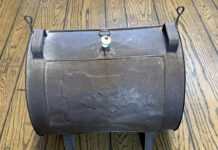Cooler temperatures are upon us, the Farm Science Review is just a few days away, as are the best seven days in September — the week-long Tuscarawas County Fair. This also means that corn silage harvest is nearly ready to begin.
The following information was provided by Bill Weiss and Mark Sulc, OSU Extension specialists, in the recent C.O.R.N. newsletter published by Ohio State University Extension Educators and Specialists.
If you interested in receiving this newsletter, please contact your county Extension office.
Because of high feed costs and low milk prices, maximizing the nutritional quality of your corn silage and minimizing shrink are more important than ever.
Maturity at chopping
At this time in the growing cycle, the most important manageable factor that will influence the nutritional value of corn silage is maturity at chopping.
Harvesting corn silage too early (i.e., silage with less than about 30 percent dry matter) usually results in a lower starch concentration in the silage, which means more corn grain may need to be supplemented.
Corn silage is usually among the least expensive ingredients in a diet and high inclusion rates will reduce feed costs.
However, because wet silage can reduce feed intake by dairy cows, dietary inclusions rates for wet silage are usually less than for normal silage which can increase overall feed costs.
Over mature corn silage (silage with more than about 38 percent dry matter) also has less nutritional value than normal corn silage because of lower fiber and starch digestibility.
Kernel processing
Kernel processing partially reduces some of the negative effects of maturity on starch digestibility and is strongly recommended for mature corn silage, but it will not make mature corn silage equal to corn silage harvested at the optimal dry matter concentration.
Guidelines
Use the following as guidelines:
– Horizontal bunkers (30 percent to 35 percent).
– Bags (30 percent to 40 percent).
– Upright, top unloading (35 percent to 40 percent).
– Upright, bottom unloading (40 percent to 45 percent).
A portion of the crop that is harvested will be lost during fermentation and storage. That loss is considered shrink.
Factors
Factors that affect shrink include the type of structure, moisture content at filling, length of chop, filling rate and air infiltration. Not covering the silage in a bunker silo greatly increases shrink.
Several studies have shown that covering a bunker with plastic returns around $8 in savings for every $1 invested in plastic and labor needed to cover the silo. For maximum benefit, cover quickly after the silo is filled.
Kernel stage is not a reliable guide for timing silage harvest. Dry matter content of whole plant corn varies with maturity.
Historically, recommendations were to harvest corn silage when kernels were at the black layer stage, but hybrids today are too dry at the black layer stage.
Through the 1990s, timing silage harvest based on the kernel milk-line position was widely recommended, but studies have demonstrated that the position of the kernel milk-line, used alone, is not a reliable indicator for determining harvest timing.
Geographic location, planting date, hybrid selection and weather conditions affect the relationship between kernel milk-line position and whole plant dry matter content.
Study
In a Wisconsin study, 82 percent of the hybrids tested exhibited a poor relationship between kernel milk-line stage and whole-plant percent dry matter.
The only reliable method of determining the optimal time to harvest corn silage is to sample the crop and directly measure the percent dry matter of whole plants.
The whole plant percent dry matter information combined with average whole plant dry-down rates can be used to roughly predict the proper time to harvest silage.
Sample a field
To sample a field, collect five to 10 representative plants from the entire field. The plants should be representative, including being from an area with representative plant population.
Collect separate samples from areas that may have different dry down rates, such as swales and knolls. Some farmers prefer sampling only two or three plants to reduce the chances of a non-representative grain to stover ratio.
In this case, choosing representative plants is even more critical. Put plants in a plastic bag, keep them cool and chop as quickly as possible.
The plants should be uniformly chopped (using a cleaver, machete, chipper shredder or silage chopper) and then mixed thoroughly to obtain a sample with representative grain to stover ratios for dry matter determination.
Dry matter content
Determine the dry matter content by drying the plant material using a Koster oven tester, microwave, convection oven or take it to a lab. Make sure the sample does not dry down and keep it cool until the dry matter determination is performed.
The accuracy of the percent dry matter value obtained will be largely determined by the amount of time and care taken in drying down and weighing the samples.
This is especially true for corn silage where whole kernels and cob pieces can be difficult to dry completely without burning the leaf tissue — I’ve done this!
Summary
Harvest timing is a critical management decision to ensure corn will be ensiled at the proper dry matter content for effective fermentation and storage. Begin sampling early, develop a harvest plan and strive to meet plant moisture guidelines. Most importantly, be safe.













it will be more helpful with pictures